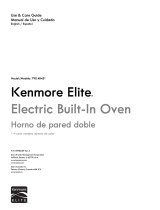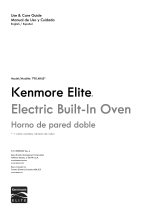
All rights reserved. Printed in the USA.
2
Table of Contents
KENMORE PRO LIMITED WARRANTY ....................................................2
Before Setting Surface Controls ..................................................................9
Setting Surface Controls............................................................................. 11
Types of Cooktop Surface Burners .......................................................11
Setting Simmer Oval’s Surface Burners .............................................. 13
Home Canning ......................................................................................... 14
Before Setting Oven Controls ....................................................................15
Glide Racks ...............................................................................................16
Oven Controls ............................................................................................. 17
Setting The Clock..................................................................................... 18
Accela-Heat ............................................................................................. 20
Setting Bake............................................................................................. 21
Setting Broil ...............................................................................................22
Setting Convection Bake ........................................................................ 23
Setting Convection Roast ........................................................................25
Bread Proof ............................................................................................. 27
Meat Probe.............................................................................................. 28
Setting the Sabbath Feature ................................................................ 30
Clean ......................................................................................................... 32
Before You Call ........................................................................................... 34
Oven Baking ............................................................................................ 34
Solutions to Common Problems............................................................. 35
Care and Cleaning ..................................................................................... 39
Cleaning Various Parts of Your Appliance ........................................ 39
Cleaning Surface Burner Heads........................................................... 41
Replacing the Oven Light ...................................................................... 41
Caring for Your Porcelain Enameled Glide Rack............................. 42
Removing and Replacing the Oven Door........................................... 43
KENMORE PRO LIMITED WARRANTY
FOR ONE YEAR from the date of sale this appliance is warranted against defects in material or workmanship when it is correctly installed, operated and
maintained according to all supplied instructions.
WITH PROOF OF SALE, a defective appliance will receive free repair or replacement at option of seller.
For warranty coverage details to obtain free repair or replacement, visit the web page: www.kenmore.com/warranty
This warranty applies for only 90 DAYS from the sale date in the United States, and is void in Canada, if this appliance is ever used for other than private
household purposes.
This warranty covers ONLY defects in material and workmanship, and will NOT pay for:
1. Cracks in a ceramic glass cooktop that are not a result of thermal shock.
2. Stains and scratches on a ceramic glass cooktop resulting from accident or improper operation or maintenance.
3. Discoloration of cooktop surfaces resulting from normal use.
4. Expendable items that can wear out from normal use, including but not limited to filters, belts, bags or screw-in base light bulbs.
5. A service technician to clean or maintain this appliance, or to instruct the user in correct appliance installation, operation and maintenance.
6. Service calls to correct appliance installation not performed by Sears authorized service agents, or to repair problems with house fuses, circuit
breakers, house wiring, and plumbing or gas supply systems resulting from such installation.
7. Damage to or failure of this appliance resulting from installation not performed by Sears authorized service agents, including installation that was not
in accord with electrical, gas or plumbing codes.
8. Damage to or failure of this appliance, including discoloration or surface rust, if it is not correctly operated and maintained according to all supplied
instructions.
9. Damage to or failure of this appliance, including discoloration or surface rust, resulting from accident, alteration, abuse, misuse or use for other than its
intended purpose.
10. Damage to or failure of this appliance, including discoloration or surface rust, caused by the use of detergents, cleaners, chemicals or utensils other
than those recommended in all instructions supplied with the product.
11. Damage to or failure of parts or systems resulting from unauthorized modifications made to this appliance.
12. Service to an appliance if the model and serial plate is missing, altered, or cannot easily be determined to have the appropriate certification logo.
Disclaimer of implied warranties; limitation of remedies
Customer’s sole and exclusive remedy under this limited warranty shall be product repair or replacement as provided herein. Implied warranties, including
warranties of merchantability or fitness for a particular purpose, are limited to one year or the shortest period allowed by law. Seller shall not be liable for
incidental or consequential damages. Some states and provinces do not allow the exclusion or limitation of incidental or consequential damages, or limita-
tion on the duration of implied warranties of merchantability or fitness, so these exclusions or limitations may not apply to you.
This warranty applies only while this appliance is used in the United States or Canada*.
This warranty gives you specific legal rights, and you may also have other rights which vary from state to state.
* In-home repair service is not available in all Canadian geographical areas, nor will this warranty cover user or servicer travel and transportation expenses
if this product is located in a remote area (as defined by Sears Canada Inc.) where an authorized servicer is not available.
Sears Brands Management Corporation, Hoffman Estates, IL 60179
Sears Canada Inc., Toronto, Ontario, Canada M5B 2C3
























